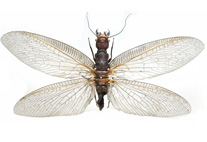Abstract
Cottus specus, a new species, is described from the karst regions of the Bois Brule drainage in eastern Missouri, USA. Cottus specus is distinguishable from all members of the genus Cottus using both genetic and morphological characters, including eye size and cephalic pore size. Cottus specus represents the first description of a cave species within Cottus. The addition of C. specus brings the total number of recognized species of Cottus to 33 in North American fresh waters.References
Burr, B.M., Adams, G.L., Krejca, J.K., Paul, R.J. & Warren, Jr, M.L. (2001) Troglomorphic sculpins of the Cottus carolinae species group in Perry County, Missouri: distribution, external morphology, and conservation status. Environmental Biology of Fishes, 62, 279–296. http://dx.doi.org/10.1023/A:1011819922403
Christiansen, K.A. (1962) Proposition pour la classification des animaux cavernicoles. Spelunca, 2, 76–78.
Cobb, B.D. & Clarkson, J.M. (1994) A simple procedure for optimising the polymerase chain reaction (PCR) using modified Taguchi methods. Nucleic Acids Research, 22(18), 3801–3805. http://dx.doi.org/10.1093/nar/22.18.3801
Culver, D.C., & Wilkens, H. (2000) Critical review of the relevant theories of the evolution of subterranean animals, In: Wilkens, H., Humphreys, W.F., & Culver, D.C. (Eds.), Subterranean Ecosystems. Elsevier, Amsterdam, pp. 389–407.
Espinasa, L. & Jeffery, W.R. (2003) A troglomorphic sculpin (Pisces: Cottidae) population: geography, morphology and conservation status. Journal of Cave and Karst Studies, 65(2), 93–100.
Fox, J.T., Adams, G., Sharum, M., & Steelman, K. (2010) Passive sampling of bioavailable organic chemicals in Perry County, Missouri cave streams. Environmental Science and Technology, 44, 8835–8841. http://dx.doi.org/10.1021/es1019367
Friesen, V.L. (1997) Intron variation in marbled murrelets detected using analyses of single stranded conformational polymorphisms. Molecular Ecology, 6, 1047–1058. http://dx.doi.org/10.1046/j.1365-294X.1997.00277.x
Greenberg, L.A. & Holtzman, D.A. (1987) Microhabitat utilization, feeding periodicity, home range, and population size of the banded sculpin, Cottus carolinae. Copeia, 1987(1), 19–25. http://dx.doi.org/10.2307/1446032
Hasegawa, M., Kishino, H., & Yano, T.A. (1985) Dating of the human-ape splitting by a molecular clock of mitochondrial DNA. Journal of Molecular Evolution, 2, 160–174. http://dx.doi.org/10.1007/BF02101694
Hillis D., Moritz, C. & Mable B. (1996) Molecular Systematics. Sinauer Associates, Sunderland, Massachusetts, 665 pp.
Huber, R., van Staaden, M.J., Kaufman, L.S., & Liem, K.F. (1997) Microhabitat use, trophic patterns, and the evolution of brain structure in African cichlids. Brain, Behavior and Evolution, 50, 167–182. http://dx.doi.org/10.1159/000113330
Huelsenbeck, J.P. & Ronquist, F. (2001) MRBAYES: Bayesian inference of phylogeny. Bioinformatics, 17, 754–755. http://dx.doi.org/10.1093/bioinformatics/17.8.754
Kinziger A.P., Goodman, G.H. & R.S. Studebaker (2007) Mitochondrial DNA variation in the Ozark Highland members of the banded sculpin Cottus carolinae complex. Transactions of the American Fisheries Society, 136, 1742–1749. http://dx.doi.org/10.1577/T06-025.1
Kinziger, A.P. & Wood, R.M. (2010) Cottus immaculatus, a new species of sculpin (Cottidae) from the Ozark Highlands of Arkansas and Missouri, USA. Zootaxa, 2340, 50–64.
Page, L.M. & Burr, B.M. (2011) Peterson Field Guide to Freshwater Fishes of North America North of Mexico. Houghton Mifflin Harcourt Publishing Company, New York, New York, 663 pp.
Posada, D. & Crandall, K.A. (1998) MODELTEST: testing the model of DNA substitution. Bioinformatics Applications Note, 14(9), 817–818. http://dx.doi.org/10.1093/bioinformatics/14.9.817
Pouilly, M. & Miranda, G. (2003) Morphology and reproduction of the cavefish Trichomycterus chaberti and the related epigean Trichomycterus cf. barbouri. Journal of Fish Biology, 63, 490–505. http://dx.doi.org/10.1046/j.1095-8649.2003.00171.x
Poulson, T.L. (1963) Cave adaptation in amblyopsid fishes. The American Midland Naturalist, 70, 257–290. http://dx.doi.org/10.2307/2423056
Proudlove, G.S. (2006) Subterranean Fishes of the World. International Society of Subterranean Biology, Moulis, France, 300 pp.
Robins, C.R. (1954) A taxonomic revision of the Cottus bairdi and Cottus carolinae species group in eastern North American (Pisces, Cottidae). Ph.D. Dissertation, Cornell University, 248pp
Robins, C.R. & Miller, R.R. (1957) Classification, variation, and distribution of the sculpins, genus Cottus, inhabiting Pacific slope waters in California and southern Oregon, with a key to the species. California Fish and Game, 43, 213–233.
Wilkens, H. (2001) Convergent adaptations to cave life in the Rhamdia laticauda catfish group (Pimelodidae, Teleostei). Environmental Biology of Fishes, 62, 251–261. http://dx.doi.org/10.1023/A:1011897805681
Williams, J.D. & Howell, W.M. (1979) An albino sculpin from a cave in the New River drainage of West Virginia (Pisces: Cottidae). Brimleyana, 1,141–146.

